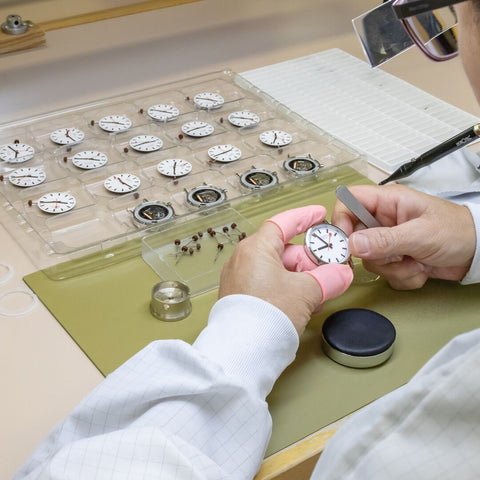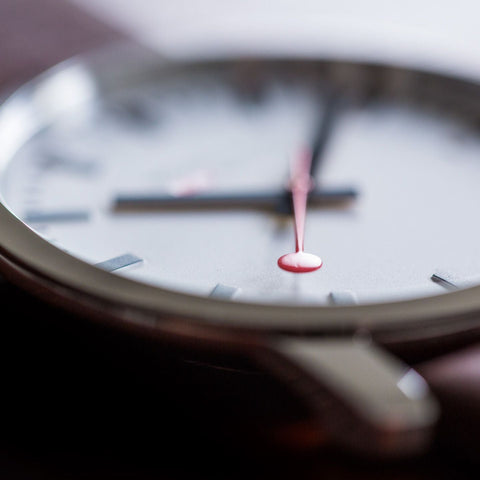Quartz revolutionised the watchmaking industry, turning it upside down in just a few years during the Quartz Revolution. While previously watches ran on a tiny and intricate system of gears, quartz introduced a brand new and more accurate way to measure time. Read more about how a quartz watch works from Mondaine, manufacturers of Swiss watches.
WHAT IS A QUARTZ WATCH?
A quartz watch, or clock, is a timepiece that uses quartz crystal, a battery and an electronic oscillator. Any watch that uses quartz as part of the mechanism is classed as a quartz watch. It’s an entirely different system from mechanical or automatic watches and is deemed one of the most accurate.
Quartz wristwatches come in all sorts of different shapes and designs, and quartz clocks are also available as free-standing or wall clocks. Since this technology was first invented, quartz watches have dominated the market and are considered the best timekeeping mechanism for any high-end timepiece.
WHAT IS ‘QUARTZ MOVEMENT’?
The term ‘quartz movement’ refers to the way the quartz and battery cause the second hand to ‘tick’, marking one second at a time. This is in contrast to automatic movement and mechanical.
Quartz movement: The second-hand ‘ticks’ by one second, pauses and ticks the next second. This is powered by a quartz crystal and battery.
Mechanical movement: The second-hand moves smoothly and continually without ticking. It is powered by winding up the watch.
Automatic movement: Uses kinetic energy from wrist movements to drive the watch’s mechanism.

BEFORE QUARTZ
To understand how a quartz watch works, it’s important to understand the way watches worked previously, and therefore the brand new function that quartz brought to the table.
For hundreds of years, people used the sun to approximate time. For many, this was as simple as getting up when it rose and going to bed when it set. When people’s worlds were smaller and they interacted less with those around the world and even around the country, this was enough.
Many people used sundials, which could have been as simple as a stick in the ground, to keep track, but these were useless without sunshine (which is often the reality in the UK!), and not very precise.
The earliest known clock dates back to 3rd century BC in ancient Greece, but it’s only around the 15th century AD that precision timekeeping and domestic clocks were first introduced.
PENDULUM CLOCKS
Pendulum clocks were the first form of precision timekeeping that were widely used. An Italian polymath called Galileo Galilei studied the way a pendulum swung and discovered that it could be used to regulate time in a clock. This idea was taken up by a Dutch scientist called Christiaan Huygens and in 1656 he designed and built the first ever pendulum clock. This was taken up in England in 1670 by a clockmaker called William Clement, who made the first grandfather’s clock.
Pendulum clocks worked due to the physics of a pendulum’s swing. A weight on the end of the pendulum regulates its swinging. As it reaches its highest point, it has lots of potential energy. Due to gravity, potential energy is then transferred into kinetic energy (movement). The weight then reaches the other side and the process repeats. Energy is repeatedly transferred in order to keep a regular rhythm. A pendulum could be designed to swing to the exact time to mark seconds.
This mechanism, with energy being transferred continually between potential and kinetic is called a ‘harmonic oscillator’. Oscillators are essential to every form of timekeeping, including quartz watches.
Oscillators cause a repeating back and forth movement of energy. In other words, a regulated and repeating movement like the swinging of a pendulum. Their predictable pattern can therefore be used to measure time.
The issue with pendulums is around accuracy and upkeep. Kinetic energy to potential (and vice versa) isn’t transferred perfectly. There are lots of factors that mean that kinetic energy decreases, such as air resistance. Eventually, the clock will slow down and become inaccurate. Pendulum clocks needed to be wound up regularly to keep the time accurately.
WATCH SPRINGS
There was also one major disadvantage of the pendulum clock: it wasn’t portable. Pendulums had to be kept in one place in order to maintain their rhythm, so a new mechanism was required to create a portable oscillator to power a watch.
The first portable watch mechanism resulting in the invention of the pocket watch around the 17th century.
These watches worked with a spring that was wound up tightly to provide power as it slowly uncoiled. They also needed an ‘oscillating mass’. Like with the harmonic oscillator in the pendulum clock, which transferred different forms of energy back and forth repeatedly, the oscillating mass in a pocket watch had the same job. This is the part of the watch that keeps the steady rhythm and is also essential to the way a quartz watch works.
It’s the oscillating mass that keeps the time. The more accurate and controlled this is the better the watch.
The first pocket watches could become inaccurate by a few hours throughout the day, and didn’t have a minute hand because the original oscillating mass was very inaccurate.
However, the balance spring and the balance wheel were invented. These oscillated at a fixed resonant frequency. Or in other words, the oscillator movement was more regular and therefore more accurate than ever before. The movement was more predictable and stayed regular for longer, so better kept track of the time.
There was one issue though; you had to remember to wind your watch! If you forgot, the watch mechanisms would stop oscillating and the watch would no longer record the time. It would slow down, then stop.

QUARTZ
To find an answer, watchmakers needed to find a material that didn’t lose energy as it oscillated and had to find a brand new way to power a watch. In order for this to happen, watch makers had to wait for the discovery of electricity and the invention of batteries. These are combined with quartz to create the watches we use today.
HOW DOES QUARTZ WORK?
In 1880, Jacques and Pierre Curie discovered that quartz had some amazing properties. The most important is that it is piezoelectric.
When quartz is compressed or bent, it generates an electric charge on its surface. It also works the other way: if a small electric charge is applied to quartz, it will compress or bend just slightly.
This might not sound too special, but it was to revolutionise the watchmaking profession. This electric charge meant that quartz had an oscillating voltage on its surface. It could oscillate (repeat a back and forth movement) extremely accurately and for a long time.
On top of that, quartz has an outstanding resilience to temperature. This means that when quartz oscillates, it isn’t affected by external conditions, like temperature, and will therefore stay accurate for a long period of time. It means that quartz makes for one of the best oscillators.
However, it would stop oscillating eventually. Imagine a bell, which creates a ringing due to vibrations. The bell it hit, the sound is created and gradually fades as the vibrations decrease. People had to find a way to keep the quartz oscillating regularly if it was going to be useful in watchmaking.
QUARTZ AND ELECTRICAL CIRCUITS
In 1928, Warren Morrison discovered that, by putting a charge through a quartz crystal, he could keep a steady beat. This was essential for the next few decades of watch developments.
It was found that the electrical charge that is naturally created on the surface of quartz crystal under pressure could be taken off the surface of the material using electrodes and an electric circuit.
The charge is then amplified through a transistor and reapplied to the quartz. The electrical charge continually moved across the quartz and ensured it oscillated constantly. The crystal’s special properties meant that almost no energy was lost during this process so it was highly efficient.
Technology combined with the quartz allowed it to keep oscillating for an extended period of time without losing any energy. It was the most accurate oscillator ever and the perfect way to power a watch.
Batteries
Every quartz watch therefore requires a battery. The battery sends electricity to the quartz through the circuit. Due to quartz’s piezoelectric properties, the battery causes it to vibrate (oscillate) at a very specific frequency: 32768 times each second.
The circuit counts the number of vibrations and uses those to create an electric pulse. Once pulse for every 32768 vibrations. One every second.
The pulses drive a motor, which turns the hands of the watch.
IN SUMMARY
A Quartz watch works as:
- A battery produces a current in the watch circuit, of which the quartz crystal is a part.
- This current causes the quartz to vibrate at precisely 32768 times a second.
- The circuit counts to oscillations and turns each 32768 vibrations into one electric pulse.
- The electric pulses power a tiny electric motor, which converts electrical energy from the pulses into mechanical energy.
- This energy turns the gears in the watch.
- The gears cause the watch hands to move around the face of the clock.
WHY IS QUARTZ USED IN WATCHES?
Quartz is used in watches because it’s at least 100 times more accurate than previous mechanisms and lasts for a very long time. Quartz watches are the best choice for reliability and accuracy.

HISTORICAL IMPACT
THE QUARTZ CRISIS
Quartz turned the watchmaking industry upside down in what was known as the quartz crisis, or the quartz revolution.
While the properties of quartz were discovered almost a century before, it wasn’t until the 1970s and 80s that quartz became commonplace in the watchmaking process.
With this change, there was huge economic upheaval as quartz replaced mechanical watches. It began when a watch called Astron was released.
Competing for Quartz
In the late 1950s and into the 60s, Swiss and Japanese watch makers were racing to make the first quartz watch. So much so, that the Centre Electronique Horloger (CEH) was established wherein twenty different Swiss watch manufacturers could collaborate to develop the first Swiss-made quartz watch.
Seiko, a Japanese company, got their first with a portable quartz clock, which they named the Seiko Crystal Chronometer QC-951. A couple of years later, they released prototypes of the world’s first quartz pocket watch. In 1967, both Seiko and the CEH in Switzerland created prototypes of the first quartz wristwatches.
However, it was Seiko that released the first official quartz watch, the Astron, in 1969. This began the Quartz revolution - also known as the quartz crisis.
Japanese Quartz Movement
Because the first quartz watch came from Japan, the mechanism through which quartz watches work is often known as Japanese quartz movement. It describes the mechanism of using quartz to power and keep time in a watch.
The Astron watch was incredibly popular and meant that watchmakers had to change their process or be left behind.
Economic Effect
There was a huge change over the 1970s and 80s as economic power shifted from Swiss watch manufacturers, who at the time still almost exclusively made mechanical watches, to Japanese manufacturers, like Seiko, Citizen and Casio.
The watch making industry saw massive upheaval, but adapted. Most established watch manufacturers embraced the change in technology and began producing their own versions of quartz watches. The era of quartz was fully underway.
Today, quartz is still the most popular mechanism used to power a watch and is found throughout the watch industry. Swiss watches from Mondaine work using quartz for the best in accuracy combined with style and design.

MECHANICAL VS QUARTZ
If you’re looking for a new watch, which mechanism should you choose?
Mechanical watches are powered using springs and have to be wound up. Quartz watches, on the other hand, use a battery combined with quartz crystal.
Quartz has many advantages over mechanical so few people opt for mechanical watches in this era. Quartz is longer lasting and around 100 times more accurate than the old mechanisms used to power watches. It is also often cheaper than mechanical alternatives.
However, some people still choose mechanical watches for their elaborate craftsmanship and aesthetic appeal.
ARE QUARTZ WATCHES STILL THE MOST POPULAR?
Since quartz was first introduced to the watch making industry, a lot has changed. The last few decades have seen huge leaps in technology and this has been reflected in watch making.
Despite the rise of smartwatches, quartz pieces still seem as popular as ever, likely due to the fact not everyone wants a watch to count their steps or notify them of messages!
Time will tell how the newest advances in technology will impact the watch making industry and the popularity of quartz watches. But we know that quartz watches, with their unbeatable accuracy and high quality mechanics, will remain popular for a long time to come.

